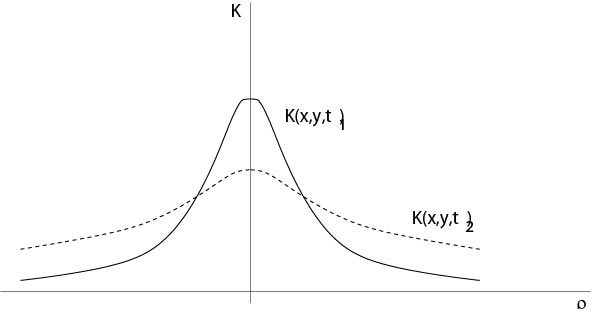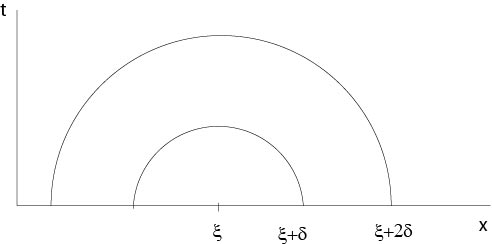6.1: Poisson's Formula
( \newcommand{\kernel}{\mathrm{null}\,}\)
Assume u is a solution of (6.2), then, since Fourier transform is a linear mapping,
^ut−△u=ˆ0.
From properties of the Fourier transform, see Proposition 5.1, we have
^△u=n∑k=1^∂2u∂x2k=n∑k=1i2ξ2kˆu(ξ),
provided the transforms exist. Thus we arrive at the ordinary differential equation for the Fourier transform of u
dˆudt+|ξ|2ˆu=0,
where ξ is considered as a parameter. The solution is
ˆu(ξ,t)=ˆϕ(ξ)e−|ξ|2t
since ˆu(ξ,0)=ˆϕ(ξ). From Theorem 5.1 it follows
u(x,t)=(2π)−n/2∫Rn ˆϕ(ξ)e−|ξ|2teiξ⋅x dξ=(2π)−n∫Rn ϕ(y)(∫Rneiξ⋅(x−y)−|ξ|2t dξ) dy.
Set
$$K(x,y,t)=(2\pi)^{-n}\int_{\mathbb{R}^n}e^{i\xi\cdot (x-y)-|\xi|^2t}\ d\xi.\]
By the same calculations as in the proof of Theorem 5.1, step (vi), we find
K(x,y,t)=(4πt)−n/2e−|x−y|2/4t.

Figure 6.1.1: Kernel K(x,y,t), ρ=|x−y|, t1<t2
Thus we have
u(x,t)=1(2√πt)n∫Rn ϕ(z)e−|x−z|2/4t dz.
Definition. Formula (???) is called Poisson's formula} and the function K defined by (???) is called heat kernel or fundamental solution of the heat equation.
Proposition 6.1 The kernel K has following properties:
- (i) K(x,y,t)∈C∞(Rn×Rn×R1+),
- (ii) (∂/∂t −△)K(x,y,t)=0, t>0,
- (iii) K(x,y,t)>0, t>0,
- (iv) ∫Rn K(x,y,t) dy=1, x∈Rn, t>0
- δ>0:(v) For each fixed
limt→0t>0∫Rn∖Bδ(x) K(x,y,t) dy=0
uniformly for x∈R.
Proof. (i) and (iii) are obviously, and (ii) follows from the definition of K. Equations (iv) and (v) hold since
∫Rn∖Bδ(x) K(x,y,t) dy=∫Rn∖Bδ(x) (4πt)−n/2e−|x−y|2/4t dy=π−n/2∫Rn∖Bδ/√4t(0)e−|η|2 dη
by using the substitution y=x+(4t)1/2η. For fixed δ>0 it follows (v) and for δ:=0 we obtain (iv).
◻
Theorem 6.1. Assume ϕ∈C(Rn) and supRn|ϕ(x)|<∞. Then u(x,t) given by Poisson's formula (???) is in C∞(Rn×R1+), continuous on Rn×[0,∞) and a solution of the initial value problem (6.2), (6.3).
Proof. It remains to show
$$
\lim_{x→ξt→0}u(x,t)=\phi(\xi).
\]

Figure 6.1.2: Figure to the proof of Theorem 6.1
Since ϕ is continuous there exists for given ε>0 a δ=δ(ε) such that |ϕ(y)−ϕ(ξ)|<ε if |y−ξ|<2δ.
Set M:=supRn|ϕ(y)|. Then, see Proposition 6.1,
u(x,t)−ϕ(ξ)=∫Rn K(x,y,t)(ϕ(y)−ϕ(ξ)) dy.
It follows, if |x−ξ|<δ and t>0, that
|u(x,t)−ϕ(ξ)|≤∫Bδ(x) K(x,y,t)|ϕ(y)−ϕ(ξ)| dy+∫Rn∖Bδ(x) K(x,y,t)|ϕ(y)−ϕ(ξ)| dy≤∫B2δ(x) K(x,y,t)|ϕ(y)−ϕ(ξ)| dy+2M∫Rn∖Bδ(x) K(x,y,t) dy≤ε∫Rn K(x,y,t) dy+2M∫Rn∖Bδ(x) K(x,y,t) dy<2ε
if 0<t≤t0, t0 sufficiently small.
◻
Remarks. 1. Uniqueness follows under the additional growth assumption
|u(x,t)|≤Mea|x|2 in DT,
where M and a are positive constants,
see Proposition 6.2 below.
In the one-dimensional case, one has uniqueness in the class u(x,t)≥0 in DT, see [10], pp. 222.
2. u(x,t) defined by Poisson's formula depends on all values ϕ(y), y∈Rn. That means, a perturbation of ϕ, even far from a fixed x, has influence to the value u(x,t). This means that heat travels with infinite speed, in contrast to the experience.
Contributors and Attributions
Integrated by Justin Marshall.


